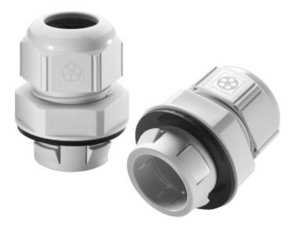Injection Moulding and Lapp

We could not imagine the world today without injection-moulded plastic parts. They can be found almost everywhere: in industry, in the home or the leisure sector - be it vehicle trim strips, engine covers or bumpers, water tanks, disposable syringes in the health sector or the micro applications of fine mechanics.
Parts can be produced economically in high volumes thanks to modern injection moulding techniques. Generally the moulding material is heated and plasticised in an injection moulding machine and forced through a die under high pressure. The void, which is known as the cavity, gives the part its shape and surface structure. With this highly complex production technique it is possible to produce injection -moulded parts ranging in weight from just a few thousandths of a gram to 70 kilos.
At the site operated by the Lapp Group in Diessenhofen, injection moulding is mainly used to manufacture SKINTOP® cable glandsand EPIC® industrial connectors. Besides the actual injection moulding machine with the die, a whole system of equipment is required for production. This involves temperature control devices, material feed units, driers, systems for removal as well as the overall infrastructure such as the power and cooling water supply as well as equipment maintenance and servicing.
To produce SKINTOP® the company uses the raw material polyamide, a semi-crystalline plastic, which is characterised by a high dimensional stability and good electrical properties. The material can also be upgraded and stabilised by adding glass fibres and mineral substances.
Polyamide however has to be handled with special care during pre-treatment and processing. It acquires its toughness and mechanical properties through water absorption of precisely 3 - 7 percent after the injection moulding process. During processing on the other hand, it should only have a very low moisture level of less than 0.1%. In production terms this means that the "damp" polyamide granulate must be dried before undergoing processing and that the finished parts have to reabsorb moisture at the end, i.e. undergo precisely defined conditioning. Apart from polyamide, the manufacture of EPIC® industrial connectors also requires polycarbonates, which are characterised by properties such as high resistance to weathering.
During the actual injection moulding process the granulate is fed into the machine via a hopper, melted at 270 -285 degrees and injected in the runners and the mould cavity at pressure of approx. 600 bar using a rotating cylindrical worm.
The manufacture of such products, which have to be manufactured with great dimensional accuracy and in high volumes, above all calls for complex die technology and detailed process expertise, in particular to achieve the shortest possible cycle times. The greatest potential for optimisation is available during cooling, which accounts for 70 % of time during the entire process. The remaining 30%, which is required for action of the machinery and forming, does not on the other hand offer such significant potential.
The entire process sequence of injection moulding is already modelled during technical project planning and design of the moulded parts with the help of relevant simulation calculations. The results of these calculations allow the experts to then decide on the design concept for the die. The key findings for the subsequent production process already become transparent thanks to the results of simulation.
Methods such as the infrared technique are used for quality control. This thermal imaging camera allows defects in the design of the die or the production process to be immediately detected. Lapp makes constant use of such techniques during development and production to achieve and maintain the high quality of its parts.

